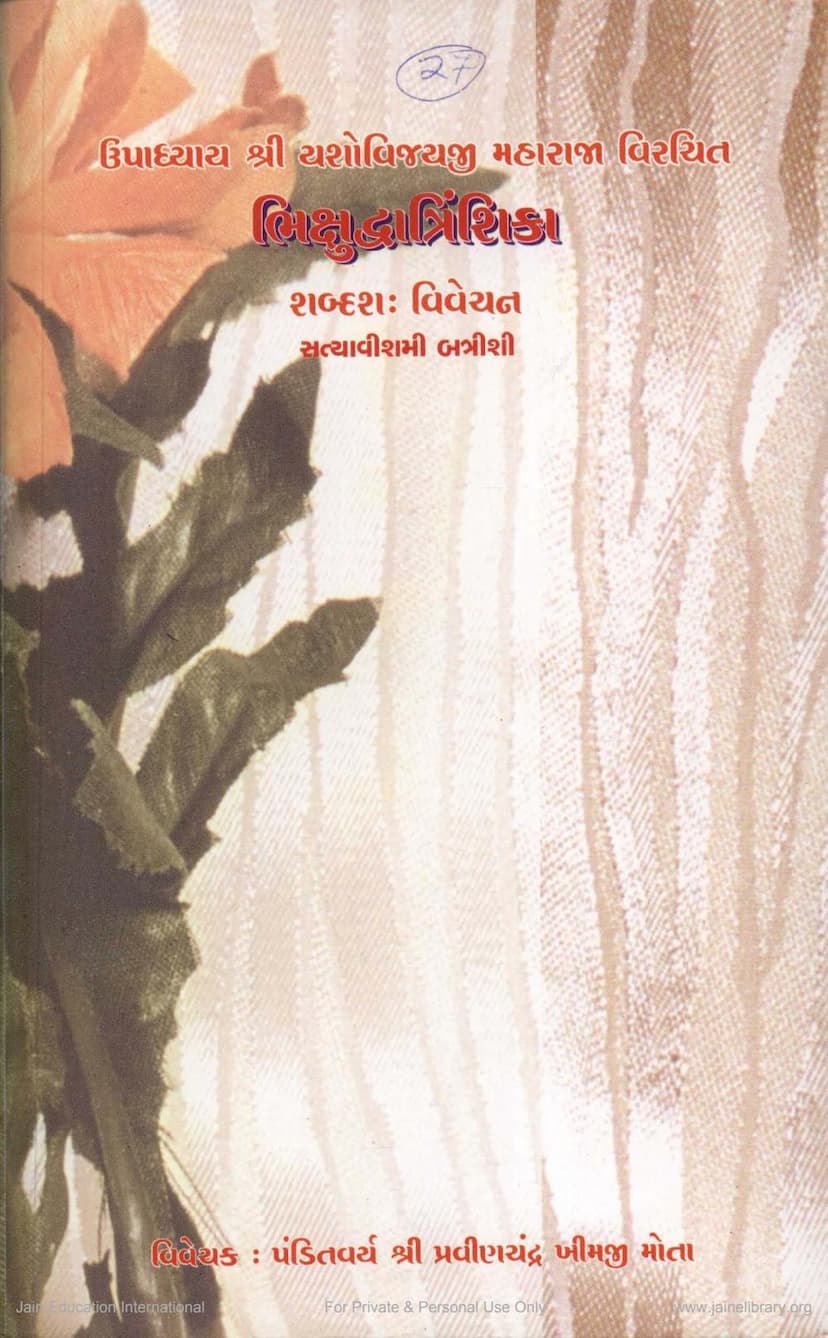Bhikshu Dvantrinshika
Added to library: September 1, 2025

Summary
The book "Bhikshu Dvātrinśikā" is a commentary and explanation of the "Bhikshu Dvātrinśikā" chapter, which is part of the larger work "Dvātrinśad Dvātrinśikā" by Mahāmahopādhyāya Shri Yashovijaya Upādhyāya. The commentary is authored by Panditvarya Shri Pravinchandra Khimji Mota and published by Gitarth Ganga.
The text provides a detailed, verse-by-verse explanation of the "Bhikshu Dvātrinśikā," which is the 27th chapter of the 32-chapter work. The original "Dvātrinśad Dvātrinśikā" is a significant work by the renowned Jain scholar Upādhyāya Shri Yashovijaya, aiming to elucidate various complex Jain philosophical concepts.
Key aspects of the book and its commentary:
- Author and Commentary: The book is a detailed elucidation of Upādhyāya Yashovijaya's work. The commentary by Panditvarya Shri Pravinchandra Khimji Mota aims to make the profound teachings of the original text accessible.
- Context of the Work: "Bhikshu Dvātrinśikā" is presented as the 27th chapter within the "Dvātrinśad Dvātrinśikā." This larger work is described as a significant contribution to Jain literature, covering diverse philosophical and ethical topics.
- Title Significance: "Bhikshu" refers to a mendicant or monk in Jainism. The chapter likely explores the characteristics, conduct, and spiritual significance of a monk, particularly in relation to the path of yoga, as indicated by the connection to the preceding chapter, "Yoga Māhātmyam" (Chapter 26).
- Purpose of the Commentary: The publisher, Gitarth Ganga, aims to preserve and disseminate the teachings of past Jain āchāryas. This commentary is part of that mission, seeking to provide a clear and in-depth understanding of the "Bhikshu Dvātrinśikā."
- Content of "Bhikshu Dvātrinśikā" (as outlined in the preface and summary):
- Definition of Bhikshu: The term "Bhikshu" is etymologically derived as one who "breaks" (bhedana) karmas. This signifies a mendicant who, through intense practice and the guidance of scripture (āgama), penetrates and breaks down the karmic obstacles to spiritual liberation.
- The "Bhāva Bhikshu" (True Mendicant): The chapter primarily focuses on the "Bhāva Bhikshu," who embodies the true essence of mendicancy through inner realization and practice, as opposed to mere outward renunciation.
- Characteristics and Qualities: The text details various qualities and practices that define a "Bhāva Bhikshu," including:
- Renunciation of worldly attachments (material and emotional).
- Discipline of mind, speech, and body.
- Adherence to the teachings of the Guru and scriptures.
- Non-violence towards all living beings (six types of life).
- Control over senses and emotions (like anger, pride, deceit, greed).
- Endurance of hardships and equanimity in adverse situations.
- Detachment from the body and its needs.
- Focus on spiritual practice and self-realization.
- Living on pure alms without attachment.
- Avoiding sinful actions and cultivating virtuous conduct.
- Living a life of detachment and renunciation.
- Synonyms for Bhikshu: The text lists numerous synonyms for a true mendicant (Bhikshu), such as Yati, Muni, Charak, Kṣapaka, Tapasvi, etc., highlighting the multifaceted nature of this spiritual ideal.
- Distinction between True and False Mendicants: The commentary clarifies the distinction between a "Bhāva Bhikshu" (one who has achieved the inner qualities) and a "Dravya Bhikshu" (one who possesses the outward form but lacks the inner substance). Various examples of "Dravya Bhikshu" are given, including those who engage in worldly activities, accumulate wealth, or perform rituals without true spiritual understanding.
- Metaphor of Gold: The text uses the metaphor of gold to distinguish between pure gold (representing the true Bhikshu with inner qualities) and alloyed gold (representing the "Dravya Bhikshu" who appears similar but lacks the true essence).
- The Goal: The ultimate aim of cultivating these qualities is liberation from the cycle of birth and death and the attainment of supreme bliss (paramānanda), which is liberation (mokṣa).
In essence, "Bhikshu Dvātrinśikā," as explained by Panditvarya Shri Pravinchandra Mota, is a profound exploration of the ideal Jain monk, emphasizing the inner transformation and rigorous spiritual discipline required to break the bonds of karma and attain ultimate liberation.